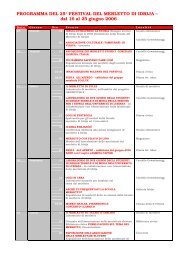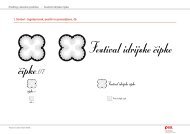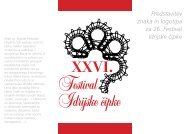VODNIK PO RAZSTAVAH ÄIPK - Idrija Turizem
VODNIK PO RAZSTAVAH ÄIPK - Idrija Turizem
VODNIK PO RAZSTAVAH ÄIPK - Idrija Turizem
You also want an ePaper? Increase the reach of your titles
YUMPU automatically turns print PDFs into web optimized ePapers that Google loves.
»ČIPKA IZ LANENE NITI«<br />
DRUŠTVO KLEKLJARIC IDRIJSKE ČIPKE<br />
MAGAZIN, 17. 06. - 03. 09. 2006<br />
Na razstavi predstavljene idrijske čipke in izdelki iz čipk so delo članic Društva<br />
klekljaric idrijske čipke. Njihov celoletni trud in ljubezen do klekljanja se že<br />
tretje leto zapored odraža v vrhunskih izdelkih, pri katerih so uporabljene<br />
preprostejše in zelo zapletene tehnike. Čipke vključujejo široki in ozki ris,<br />
sukani ris, polpremet, ažur, kitice, rožice iz kitic in ribic, luknjice, možgane,<br />
tulipane, pajke, satovje, slince, kantu rožice, rožice z listi, figure. Večina vzorcev<br />
izhaja iz zapuščine znanega idrijskega trgovca Franca Lapajneta. Zaradi lanene<br />
niti daje nežna struktura idrijske čipke pridih tradicije. Cilj klekljaric je, da<br />
vsako leto v okviru Festivala predstavijo idrijsko čipko v novi obliki oziroma<br />
vsebini. Postavitev letošnje razstave Društva klekljaric idrijske čipke je nastala v<br />
sodelovanju s študentkami oblikovanja tekstilij in oblačil NTF Oddelka za<br />
tekstilstvo Univerze v Ljubljani. S sodobnim pristopom postavitve so<br />
študentke želele prikazati življenje tradicionalne klekljane čipke v<br />
današnjem času. Tekstilije ne zavračajo starih zakoreninjenih motivov,<br />
oblik in struktur, ki so v dolgih letih pridobile vrednost in pomen. Treba<br />
jih je le spreminjati v kontekstu življenja, v umeščanju v novo okolje. Stari<br />
ornamenti, spremenjeni le v barvi ali velikosti strukture, se vključujejo v<br />
sodobna oblačila in dobijo mesto v modernem okolju ter pripovedujejo<br />
stare dragocene zgodbe. Drugačna postavitev razstave nagovarja k novem pogledu<br />
na staro čipko in druženju z njo v sodobnem življenju.<br />
Andra Marinko, Vera Sešlar Založnik<br />
LINEN THREAD LACEWORKS<br />
IDRIJA BOBBIN LACE MAKERS ASSOCIATION<br />
MAGAZIN, 17.06. - 03.09. 2006<br />
<strong>Idrija</strong> lace and other lace products presented on this exhibition are the work of members<br />
of the <strong>Idrija</strong> Bobbin Lace Makers Association. Their year-long effort and love towards lace<br />
making has for the third year in a row been reflected in top quality products, which employ<br />
not only simple and easy-to-acquire techniques, but also very complicated ones. Therefore,<br />
laceworks include wide and narrow lines, twisted lines, half-turn, small plaits, flowers of plaits<br />
and fish, holes, brain, tulips, spiders, honeycomb, kantu flowers, flowers, flowers with leafs,<br />
figures, etc. Most patterns originate from the legacy of the known <strong>Idrija</strong> tradesman Franc<br />
Lapajne. With the use of linen thread the soft structure of the <strong>Idrija</strong> lace gives a touch of<br />
tradition. The goal of bobbin lace makers is to introduce the <strong>Idrija</strong> lace in a new form or<br />
content on the festival each year. The setting of this year’s annual exhibition of the <strong>Idrija</strong><br />
Bobbin Lace Makers Association appeared in cooperation with students of textiles and<br />
clothing design of the Department of Textiles, Faculty of Natural Sciences and Engineering<br />
of the University of Ljubljana. Their intention regarding this modern approach of the setting<br />
was to introduce the life of the traditional bobbin lace today. Textiles do not reject old deeply<br />
rooted motives, forms and structures, which have acquired meaning and value through time.<br />
Textiles only require changes in the context of life, in placing in the new environment. Old<br />
ornaments, changed only in terms of colour and size of the structure, are included in modern<br />
clothing and are given place in modern ambient, through which they tell old precious stories.<br />
A different organization of the exhibition urges us to look in a new way, and make friends<br />
with old lace in a contemporary setting.<br />
Andra Marinko, Vera Sešlar Založnik<br />
»IL MERLETTO CON FILATI DI LINO«<br />
ASSOCIAZIONE DELLE MERLETTAIE DI IDRIJA<br />
MAGAZIN, 17.06. - 03.09. 2006<br />
I merletti di <strong>Idrija</strong> ed i manufatti di merletto presentati nell’ambito della mostra sono<br />
opera delle componenti dell’Associazione delle merlettaie di <strong>Idrija</strong>. Il loro impegno lungo<br />
un anno ed il loro amore verso il merletto si riflette già per il terzo anno consecutivo<br />
negli artefatti meravigliosi, per elaborare i quali non sono state utilizzate solamente le<br />
tecniche più semplici, bensì soprattutto quelle più complesse. I merletti comprendono<br />
quindi il motivo largo e quello stretto, il mezzo punto, il punto traforato, le trecce, i fiori<br />
di trecce e di pesci, i buchi, le volute, i tulipani, i ragni, il nido d’ape, i fiori di cantù, i fiori e<br />
foglie, le lagrime nonché varie figure. La maggior parte dei modelli appartiene all’eredità<br />
del commerciante locale Franc Lapajne. Mediante l’utilizzo del filo di lino la struttura<br />
soave del merletto di <strong>Idrija</strong> assume una parvenza tradizionale. Lo scopo delle merlettaie<br />
è presentare ogni anno nell’ambito del Festival il merletto d’<strong>Idrija</strong> in forme e contenuti<br />
nuovi. L’allestimento della mostra di quest’anno da parte delle merlettaie di <strong>Idrija</strong> è stato<br />
effettuato in collaborazione con le studentesse di design di tessili e vestiario della Sezione<br />
per i tessuti dell’Università di Lubiana. Con un approccio moderno dell’allestimento le<br />
studentesse hanno inteso illustrare il ruolo del merletto a tombolo tradizionale nella<br />
realtà quotidiana, non rifiutando assolutamente gli antichi e radicati motivi, le forme e le<br />
strutture che attraverso il tempo hanno acquisito valore e significato, ma semplicemente<br />
adeguandole al contesto della vita e collocandole nel nuovo ambiente. Gli antichi<br />
ornamenti, modificati solamente nel colore o nella grandezza della struttura, vanno<br />
inclusi negli abiti moderni ed assumono un posto di rilievo nell’ambiente quotidiano,<br />
narrando favole antiche e preziose. Il diverso allestimento della mostra invita ad un<br />
nuovo approccio al merletto antico nel contesto moderno.<br />
Andra Marinko, Vera Sešlar Založnik






